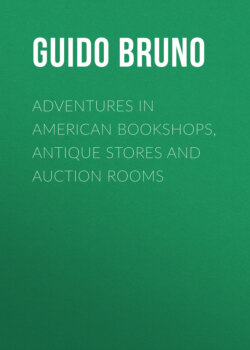Читать книгу Adventures in American Bookshops, Antique Stores and Auction Rooms - Guido Bruno - Страница 10
The Strange Discovery and Disappearance of Stuart’s Washington
ОглавлениеANTIQUE shops are isles of romance and mystery in the commonplace everyday life of New York, but if you wish to enter into the real thrill of adventure, you must forget the fashionable shop, where antiques have found a temporary resting place and you must not talk to the shop-keeper. Antique shops along Fifth Avenue and the main streets are conducted as up-to-date business places, and up-to-date business has a romance of its own, a twentieth century romance that has little to do with the individual and less with sacred time-honored traditions that touch the heart. Most antique dealers kill the charm their curios and works of art awaken in us.
They know the prices of the beautiful and ugly things on sale in their shops, but they don’t know their value. Antique dealers are painful whenever they try to impress you with their knowledge of art or of association or history, or when they simply play on the vanity of prospective customers, telling in whose possession the priceless object has been, quoting prices like stock brokers.
Whenever I spend some time in an antique shop I think of George Bernard Shaw’s essay: “On Going to Church”: “What wonderful and ideal places would churches be if there were no priests and no services to disturb the sublime quiet and the elevating beauty of the edifices.” What charming places for dreams and revery would antique shops be if there were no antique dealers and no ambitious millionaires, who wish to show their appreciation of art by paying exorbitant prices for art objects.
“Then the museum is an ideal place,” I hear you say. No, it isn’t. The museum is a mausoleum of art. The art objects there seem to me buried forever in costly catacombs with beautiful monuments and tombstones, but buried away from our world, separated from life forever; yet the beautiful things done by past generations should be a part of our own throbbing life.
The great antique dealers are not the high-priests of the beautiful in New York. Suave and well-meaning gentlemen; their words come not from their hearts and their love is tied to the price of their wares and not to their merit. Some of these gentlemen have sold shoes, shirts, furniture and cash registers before they went into the “antique business.” Works of art are mere merchandise to them. Money-changers they are in the temple, but the temple is theirs, too; no one ever can chase them out.
“Names” are their gods. Authenticity their dogma. The art of persuasion their greatest asset. To find big names (names that bring high auction prices) is their constant desire and to sell these names to the highest bidder at fabulous prices is their daily dream.
What do I care who painted a portrait? Perhaps it is a priceless Velasquez or Rubens or Botticelli or by some unknown artist of several hundred years ago? But I like to contemplate the person who sat for the portrait; the beautiful girl in her strange attire; I like to dream about the love, hatred, contempt, affection, about all the hopes and all the despair mutely witnessed by some old-fashioned writing cabinet with secret drawers and dozens of pigeon-holes, where once letters reposed that meant so much to the writers and recipients. I like to think of the soft, well-cared-for hands of some Prince of the church, who wore the beautiful Bishop’s ring hundreds of years old that will adorn perhaps tomorrow the jewel-case of an American millionairess.
There are divans and chairs. … Who used them? In whose home have they served? Where will they go to from here? The mystery and romance woven around all the various works of art and useful objects that have withstood the destructive powers of time and men is captivating. How did all these things get into the fashionable antique stores?
Most of them were purchased from other antique dealers; some were bought in auctions and obscure places and a few were purchased from another kind of antique dealer who are not very infrequent in New York.
Where there is mystery there are surely people who wish to solve the mystery, and very curious people are these “detectives of the antique.” The peripatetic antique dealers are in a true sense connoisseurs. They prowl about all sorts of out-of-the-way places; storage houses, auction rooms, in garrets of houses that will be torn down and in cellars of old family dwellings, unoccupied perhaps for generations. They sense the value of a thing the moment they see it. Some of them are scholarly gentlemen who have a great book knowledge, who know more than professors in our universities and curators of our museums. Others know by intuition. And a few have the instinct of a Sherlock Holmes and the sense of adventure of a pirate.
Some weeks ago I noted the following advertisement in the American Art News. It sounded mysterious as well as promising:
